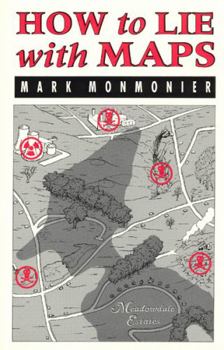How to Lie with Maps
Select Format
Select Condition 
Book Overview
An instant classic when first published in 1991, How to Lie with Maps revealed how the choices mapmakers make--consciously or unconsciously--mean that every map inevitably presents only one of many... This description may be from another edition of this product.
Format:Paperback
Language:English
ISBN:0226534154
ISBN13:9780226534152
Release Date:May 1991
Publisher:University of Chicago Press
Length:183 Pages
Weight:0.62 lbs.
Dimensions:0.5" x 5.5" x 8.5"
Customer Reviews
5 ratings
Little White Lies
Published by Thriftbooks.com User , 14 years ago
All maps are 'lies' to some degree. Some of the book was required reading in a course on Cartography. With a little bit of effort the reader can learn what to look for and how to avoid the inadvertent or unintentional 'lies'. Worth the effort!
Learn how to make a map lie!
Published by Thriftbooks.com User , 15 years ago
The title is not deceiving at all. This book walks you through the most common cartographic deceptions, and provides some excellent color guides. If you want to learn how to make influential maps for a cause, this is the book!
maps lie and lies on the map
Published by Thriftbooks.com User , 18 years ago
ab useful guide to understand the tricks of the cartographic power. to learn how to be aware of the misuse and abuse of all type of maps. A milestone in the literature of Cartography.
A useful addition
Published by Thriftbooks.com User , 20 years ago
Maps are one of hte commonest kind of information graphic. They occur in many forms, in many contexts, and commonly carry more data per square inch than just about any other kind of diagram. Also, a map carries some sense of authority and may even inspire a kind of loyalty - surely you know at least one map fanatic? That carrying capacity and authority can be used badly as easily as used well: incompetently, to make some point at the expense of others, or intentionally to misdirect. The book's first section reminds us that every map contains mis- or missing information - if only because the world is round and the map is flat. Later, Mommonier gives examples of incompetence showing how information, especially in color, can be illegible. He also shows how maps can affect political decisions as close as your own back yard, the maps used to make land planning and zoning decisions. He works up from town hall politics to the international scale, including some remarkable Cold War artifacts. He mentions esthetics only briefly, mostly to point out how the decision to make a map look nice can corrupt its data content. This is a loss since esthetics don't inherently conflict with the message, but good illustrators already know how to create visual appeal and bad ones should not be encouraged. This is a useful addition for anyone who creates or uses information in picture form. It's not as broad as other books, but adds depth to discussions about one particular kind of information graphic. The wide ranging and well categorized bibliography is just an extra. //wiredweird
Not just how to lie with maps, but how they're made
Published by Thriftbooks.com User , 20 years ago
This book is about maps in general, which must, as a matter of necessity, reduce the level of detail from the reality they represent. So all maps "lie" in that regard. This book then explains how maps can be made that distort the perception of reality through a variety of methods, both unintentional and otherwise. Along the way, the reader will learn about many different types of maps and the kinds of problems to look out for when using maps.





